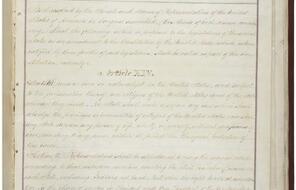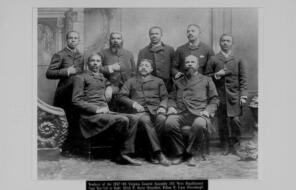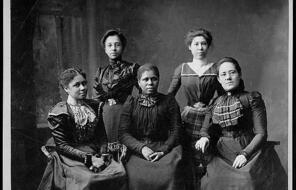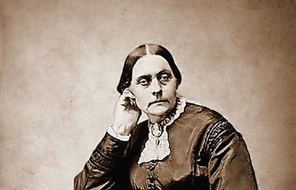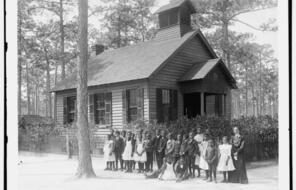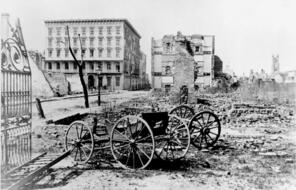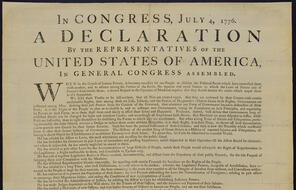As the Civil War ended, the country and its lawmakers faced the daunting challenge of bringing the North and South back together and forming a unified nation. This task was all the more complicated given the fact of Emancipation, the aspirations of freedpeople across the South, and the tension between these factors and the belief in white supremacy held by many Americans. Historian David Blight describes the challenges of the era as a balancing act between two competing, and sometimes mutually exclusive, goals:
The challenge of Reconstruction, and it’s the challenge we’ve had ever since, is: How do you do two profound things at the same time? One was healing and the other was justice. How do you have them both? What truly constitutes healing of a people, of a nation, that’s suffered this scale of violence and destruction, and how do you have justice? And justice for whom?
Students will see that one of the primary political conflicts of the era stemmed from disagreement over exactly what the proper balance of these principles—healing and justice—should be. In the two years following the end of the Civil War and Lincoln’s assassination, a political battle between President Andrew Johnson and a group of Republicans in Congress known as the Radicals ensued. In this lesson, students will look closely at Johnson’s Presidential Reconstruction plan, and they will be exposed to the Radical Republican criticism of that plan. In the process, they will uncover disagreements between Americans over the rights of the victorious North to impose its will on the defeated South and over the rights and status that white and Black Southerners each ought to be granted in the Southern states.
The Presidential Reconstruction Plan
Andrew Johnson assumed the presidency following Lincoln’s assassination in April 1865, and within a month he began to implement his plans for Reconstruction, which became known as Presidential Reconstruction. Johnson was a Democrat from eastern Tennessee whose loyalties toward poor Southern whites led him to detest the slaveholder aristocracy and remain a staunch supporter of the Union during the Civil War. In fact, he was permitted to keep his seat in the U.S. Senate after the war began because he remained loyal to the Union, despite his state’s secession. Later in the war, Lincoln appointed Johnson military governor of Tennessee, where he earned a reputation for taking strong action against Confederates in his state. Lincoln then brought Johnson onto the 1864 ticket because he had the backing of loyalist white Southerners to whom Republicans could appeal for support after the war. However, Johnson had little concern for the rights or needs of freedpeople beyond their emancipation. He believed in white supremacy, and, as his Reconstruction policies and public speeches reflected, his belief in white supremacy was stronger than his dislike for the wealthy Southern planter class.
Johnson argued that, since he believed secession was illegal, the rebellious states had never truly left the Union. Therefore, their relationship to the federal government ought to be restored as expediently as possible, and white supremacy, the political and social order that prevailed before the war, ought to continue, absent slavery. Announced in May 1865 while Congress was in recess (Congress would not reconvene until December), Johnson’s plan granted amnesty, including the restoration of property, to the vast majority of Southern whites who supported the Confederacy as long as they were willing to take an oath of loyalty to the Union. High-ranking Confederate military officers, political leaders, and planters with more than $20,000 in wealth were required to apply individually to Johnson for a pardon in order to regain their rights and property. Johnson ultimately granted requested pardons liberally, so by Fall 1865, most ex-Rebels were considered citizens in good standing.
Presidential Reconstruction also provided for the rapid readmission of Southern states to the Union. Johnson called for Southern states to hold constitutional conventions to amend their pre-war constitutions to comply with federal law and accept the Thirteenth Amendment. Eligibility to vote for convention delegates was determined by each state’s pre-war constitution, thus excluding those who were enslaved before the war (as well as anyone not yet granted amnesty or pardon) from the process of revising the state constitutions. This guaranteed that white supremacy would continue to prevail in the post-war state governments even in the absence of slavery. David Blight summarizes Johnson’s philosophy of Reconstruction with this phrase: “The Constitution as it is, and the Union as it was.”
The Radical Republican Vision
Radical Republicans, a progressive minority of the Republican Party, believed that Johnson’s approach was wholly unacceptable, and the Radicals’ position gained support from moderate Republicans as conflict between the president and Congress erupted in 1865 and 1866. What was especially threatening to Republicans was that under Johnson’s plan, Southern Democrats stood to gain a level of representation in Congress greater even than it was before the war. This was because the “three-fifths” clause was no longer operative in the Constitution after the abolition of slavery.
Each freedperson now counted as a full person when determining the number of representatives each state would send to Congress and the Electoral College. However, as former Confederates regained control of Southern governments under Presidential Reconstruction, it became clear that they would prohibit freedpeople from voting, enabling white Democrats to dominate the elections.
Radical Republicans maintained that the federal government, as the victor in war over the former Confederacy, had the right to impose significant political and social changes, chief among them voting rights for freedpeople. Countering Johnson’s goal of restoring the states of the South, Representative Thaddeus Stevens argued that Congress must remake them: “The whole fabric of southern society must be changed, and never can it be done if this opportunity is lost. Without this, this Government can never be, as it never has been, a true republic.”
If the Southern states would not be remade, Radical Republicans asked, then which side had really won the war? While they had not formulated a specific plan for Reconstruction in 1865, Radical Republicans coalesced around the ideal of equal rights. In particular, their vision for remaking the South included voting rights for Black males, the establishment of new state governments in the South recognizing these voting rights, and strong federal protection for the rights of former slaves. Moderate Republicans were more pragmatic than the Radicals, whom they outnumbered. Moderates initially hoped to work with President Johnson to restore the Union rather than wholly remake it. As we will see in subsequent lessons, the realities of Presidential Reconstruction, as well as Andrew Johnson’s combative response to Republican efforts to modify his policies, would prompt moderate Republicans to take positions closer to those of the Radicals.
By examining the opposing philosophies for Reconstruction put forth by Andrew Johnson and Radical Republicans, students can begin to consider the difficulties of balancing healing and justice after a cataclysm such as the Civil War. They might consider the difficult choices and questions faced by political leaders at the time: Whose voices should be included in the process of “binding up the nation’s wounds”? Who should be included and who should be excluded in the nation that would emerge from Reconstruction? Could the nation heal if former Confederates felt that they were being punished by a loss of power and status? Could democracy thrive if African Americans were not guaranteed equal rights in the new nation? How could the nation balance the goals of healing and justice?







